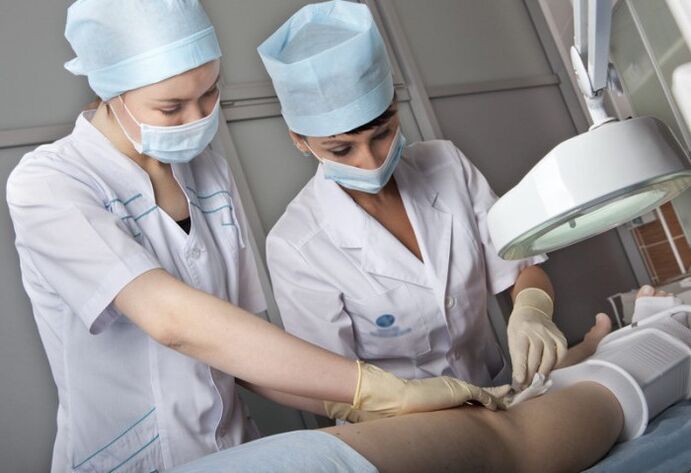Progressive varicose veins cannot always be successfully cured with conservative treatment methods. So, varicose veins are removed through surgery. Surgical treatment of lower limb varicose veins has its own characteristics, rehabilitation methods and contraindications.

In what cases is varicose vein surgery performed?
The following situations require surgery and should only be performed in a hospital by experienced specialists. Lower limb surgical intervention is required in the following cases:
- If the disease has spread and progressed;
- If the saphenous veins become very large;
- If the movement of blood through the vessels is interrupted, that is why the legs constantly hurt, quickly get tired and become overloaded with heaviness;
- If the skin is nutritionally affected;
- If there are non-healing trophic ulcers on the legs;
- If thrombophlebitis worsens.
How to prepare for surgery
Surgery to treat varicose veins is called phlebectomy. It is important to prepare well for it in advance. Treatment of varicose veins with surgical intervention begins with passing all the necessary tests and undergoing the necessary studies of the body. On the day of surgery you will need to:
- Morning shower;
- Shave your legs so that excess hair does not interfere with the work of the doctor treating varicose veins;
- Arrive at the hospital a little earlier than your appointment to prepare for the upcoming procedure.
In case of phlebectomy under general anesthesia, the patient will be given a cleansing enema in the evening.
If the doctor prescribes surgical treatment of varicose veins in the legs, it is important to inform the doctor about the presence of an allergic reaction to the drug to avoid serious consequences. Surgery is performed using anesthetics and iodine-containing substances. Therefore, if you are allergic to these drugs, you must inform your doctor.
If after lower extremity surgery, the patient needs to stay in the hospital for rehabilitation, the doctor must also systematically inform the doctor about the drugs he is taking.
Types of operations for varicose veins
Varicose veins of the lower extremities are treated in many different ways. There are the following types of surgical intervention:
- During phlebectomy, only veins affected by varicose veins are removed. Diseased veins are removed through small incisions in the leg;
- To remove the great saphenous vein along with its branches, stripping is performed. This varicose vein surgery is performed through an incision in the groin fold. The veins that have undergone surgery are ligated and tightly bandaged to the leg;
- During sclerosis, diseased blood vessels are filled with a special substance that glues them together. Instead of diseased veins, scar tissue appears, which, with the help of special preparations, then disappears without a trace;
- Treatment of varicose veins in the lower limbs is carried out using a laser beam that penetrates the veins through special punctures. With laser therapy, the veins are welded together, dissolve and disappear after a while. Reviews from patients indicate that such surgical intervention is quite effective, due to which the disease does not recur.

Leg surgery to treat varicose veins is no longer scary today. All interventions are performed through a small incision in the skin. 24 hours after surgery, the patient can be discharged home and after a few days is allowed to return to work.
It is important that before undergoing foot surgery, patients are aware of the possible consequences. Rehabilitation takes place in different ways. Treatment after surgery depends on how it was performed, in what area, and under what type of anesthesia. Usually after a vein cut, the leg is seriously damaged, a hematoma even appears and disappears after a while. During laser treatment, slight pain is felt in the lower limbs.
Rehabilitation after surgery
After lower extremity surgery, recurrence is very rare. The patient's further health depends only on him. To avoid hematomas, bleeding and other complications, you must strictly follow all your doctor's recommendations.
When surgical treatment of varicose veins is left behind, it is important to carry out the following rehabilitation measures:
- Get enough rest;
- Take a walk outside;
- Exercise, taking into account the permissible load, is determined for each patient;
- Follow a diet;
- Tightly bandage the surgical area on the leg with an elastic bandage;
- Wear special knitted compression underwear;
- Do not lift heavy objects;
- Track your weight.
After lower limb surgery, it is strictly forbidden to drink alcohol, do heavy work, take hot baths or drive for two days.
Within four days, pain in the lower extremities and increased body temperature may occur. To deal with such unpleasant symptoms, you should massage your feet. To quickly restore blood flow and increase the tone of the veins, exercise is recommended.
To prevent blood clots, treatment of varicose veins after surgery is performed with antiplatelet drugs. Your doctor may prescribe a course of treatment with acetylsalicylic acid. To thin the blood, the patient is injected with glycosaminoglycan.
Treatment or prevention of the inflammatory process is carried out with the help of antibiotics. To relieve pain in the lower extremities, painkillers are prescribed.
You need to be very careful when performing cleaning on the operated leg. Don't get the bandage wet before removing the sutures! The stitches will be removed seven days after surgery, once the wound has completely healed.
Once they are removed, you need to bathe carefully. You cannot forcefully tear off the scabs near the scar, they will fall off on their own. When bathing, wash your feet gently with a soft sponge and baby soap. Then they are wiped with a soft towel, and the scar lines are smeared with alcohol or brilliant green. You should not steam scars in a sauna or hot bath for a month.
How to eat during rehabilitation
To strengthen blood vessels, it is recommended to drink a little dry red wine, beet or tomato juice, grape juice, eat cranberries, garlic and lemon.
For varicose veins, you should:
- Drink apple cider vinegar twice a day. Two tablespoons should be diluted with half a cup of water;
- Among vegetables, cabbage, bell peppers, tomatoes, carrots and herbs are considered useful. You can prepare salads from them, seasoning them with vegetable oil or lemon juice;
- As for fruits, you should eat gooseberries, black grapes, oranges, strawberries, apples, lemons;
- To saturate the body with useful substances, prepare cereal porridge;
- To enrich your veins with vitamin E, add vegetable oils to your dishes - olive, pumpkin or sunflower;
- To saturate the venous system with elastic, it is important to have seafood in the diet. You should eat seaweed every day. If your income allows, make salads from mussels, crabs, shrimp, clams, and squid;
- To maintain vascular health, consume a few walnuts daily.
Only a reasonable and balanced diet will help you recover faster after phlebectomy.
Complications and consequences can occur after surgery
In general, surgery to treat varicose veins in the extremities goes well. If surgical treatment is successful, the patient will be discharged home after two days. But sometimes unwanted complications occur that you need to know in advance.
Complications that can occur after surgery on the limbs:
- The formation of bruises disappears on its own within a month. Very rarely do they stay on the skin for more than two months;
- Sometimes in places of punctures or incisions, the skin begins to thicken. Within a month, the seal will disappear on its own;
- If the skin incision touches nerve endings, the patient may feel pain in this area. It also takes some time for the wound to heal completely;
- If the leg is subjected to heavy loads after surgery, swelling may occur. Therefore, in the first few days after vein surgery, heavy work should be avoided.
To avoid the described consequences after surgery, it is necessary to carry out prevention.
Precautions
Some people's wounds heal quickly, while others develop keloid scars. For this reason, varicose veins need not only to be eliminated, but also to take all precautions to avoid unwanted consequences.
After surgery, experts advise you to move around and not sit in one place or lie in bed.
Postoperative precautions are as follows:
- First, slowly bend and straighten your knees. Make circular movements with your legs to speed up venous blood circulation;
- When sleeping, make sure your legs are slightly higher than your torso;
- After a few days, begin to actively sit up in bed;
- Place an elastic bandage on your operated leg and begin walking and doing light physical therapy exercises. An elastic bandage should be worn for three months after surgery.
To prevent the disease from returning, it is important to lead an active lifestyle, do physical therapy, go to the pool and eat a healthy and balanced diet.
To avoid the development of varicose veins and eliminate varicose veins, you need to exercise, run, walk a lot, swim and attend yoga classes.
If you stand a lot during the day, you need to take short breaks every two hours - walk on your heels and then on your toes. To avoid varicose veins during pregnancy, special compression stockings or tights should be worn.
Contraindications to varicose vein surgery
It is not always possible to remove veins with varicose vein surgery. Treatment of the disease with surgical intervention cannot be carried out for people with hypertension (late stage of the disease), coronary artery disease, severe forms of infectious diseases, erysipelas and eczema.
This operation is also contraindicated during pregnancy (especially from 5 to 9 months) and in old age.
It is important that the varicose vein removal operation is performed by an experienced surgeon. Therefore, in order not to endanger your health, you need to carefully read the reviews of different doctors. Only after carefully analyzing the information collected about the doctor can you go to your chosen specialist and trust him with your problem.
What to do if surgery is contraindicated for you
If for some reason you cannot have surgery, treatment of varicose veins is carried out using conservative methods. The early stages of the disease can be treated as follows:
- Thanks to compression garments, bulging blood vessels can be kept intact. To choose the right compression, you need to consult your doctor;
- You can make ointment to treat foot pain from yogurt and mugwort decoction. A compress made from hops, an alcoholic tincture from Kalanchoe leaves, cabbage with honey or raw potatoes will also be useful;
- The early stages of varicose veins are treated with hirudotherapy. For treatment, people use leech saliva to thin the blood and help it circulate better through the veins. But after this therapy, sometimes small scars remain on the skin;
- For healing, lotions, masks or baths are also made from green clay;
- After consulting a doctor, varicose veins in the legs can be treated with special pharmaceutical ointments, creams, patches, gels or tablets.
The described conservative methods can be used only in the early stages of the disease. If varicose veins have severe symptoms, surgery cannot be avoided. Therefore, it is important to consult a doctor promptly to protect the health of your feet.
How do patients respond to varicose vein surgery on the legs?
If you carefully study all the reviews about surgical intervention for varicose veins, you can draw the following conclusion. If you are scheduled for surgery, there is no need to fear. Please feel free to do so and strictly follow any further instructions from your doctor. And you will soon forget about varicose veins and all its unpleasant symptoms.
Now you know what types of surgical interventions are possible for varicose veins in the legs. How to prepare for surgery and what to do after surgery to avoid unwanted complications and recurrence.

























